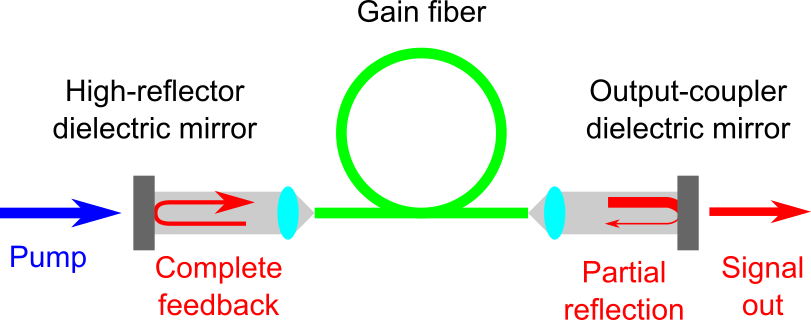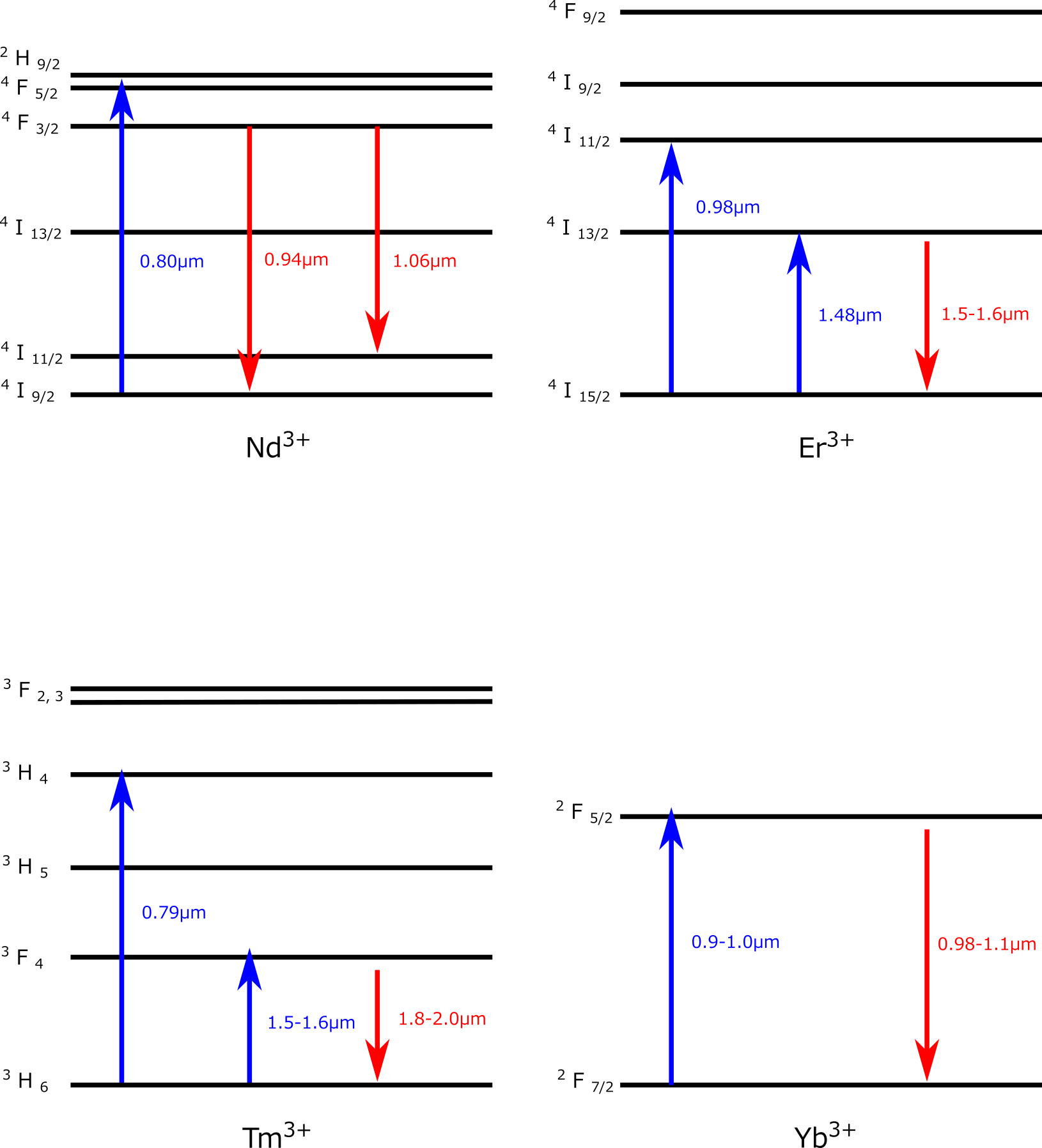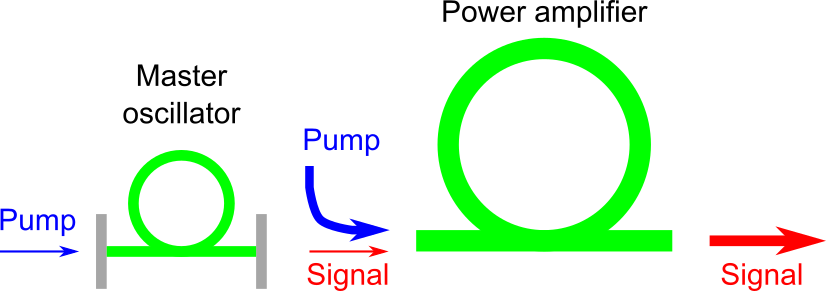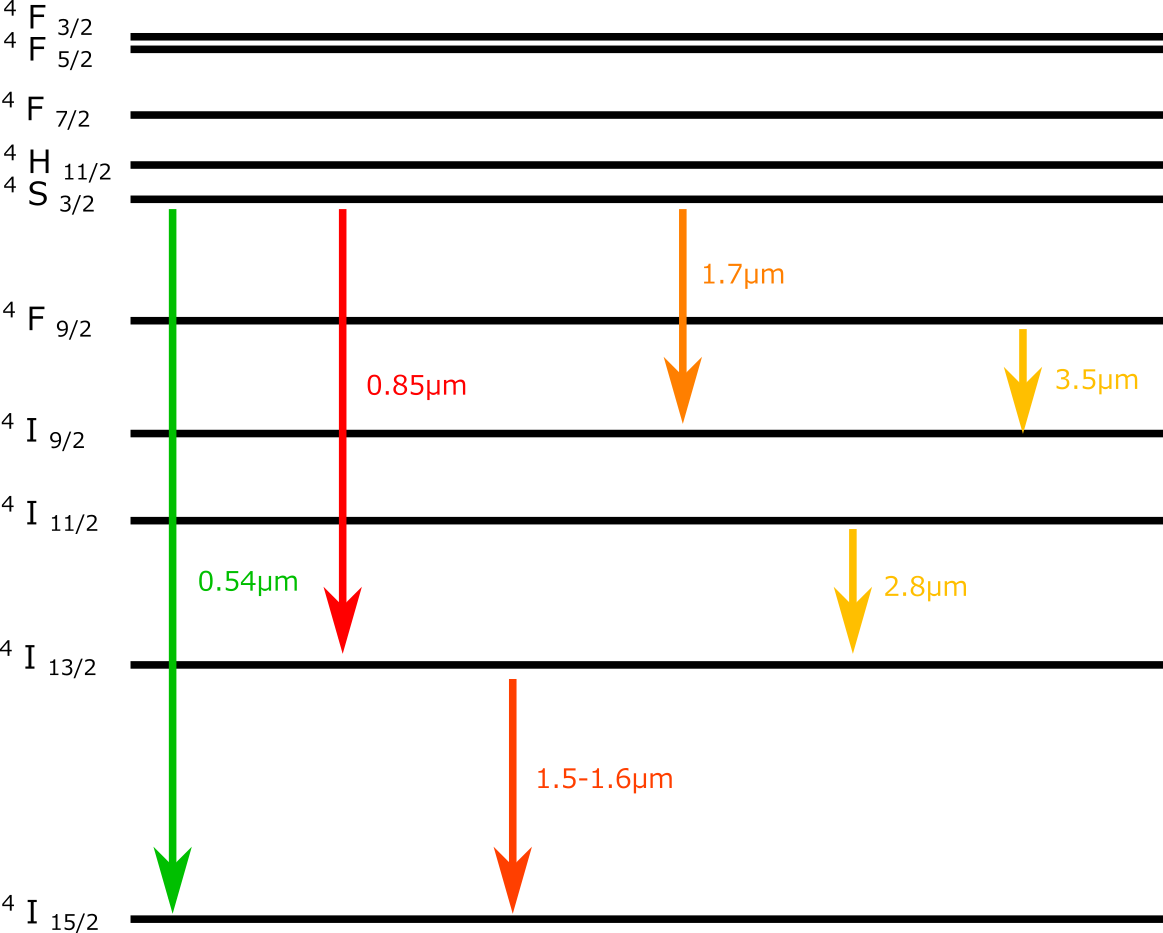JAPANESE / ENGLISH

JAPANESE / ENGLISH
Last updated on 05/7/2021
Fiber lasers are one class of solid-state lasers in which the gain medium is an optical fiber. Fiber lasers have been a key technology in the area of solid-state lasers, since the first proposal of using an optical fiber as a mode selector for lasers . An example of basic fiber laser configurations is shown in Figure 1.

Figure 1: Schematic of fiber laser
Stimulated emissions from the gain fiber coherently amplify the signal as the signal repeatedly bounces back between the two signal reflectors. The reflector on one end of the cavity is a high reflector (ideally 100% reflectivity at the signal wavelength) in order to maximize the signal feedback to the cavity. The reflector on the other end of the cavity is a partial reflector (also called an output coupler) for extracting the signal out of the cavity, as well as providing the signal feedback to the cavity.
The output from a fiber laser can be either continuous wave (CW) or pulsed. Pulsed fiber lasers are created by modulating the loss of the laser cavity, and the pulsewidth is determined by the temporal profile of the loss modulation and the chromatic dispersion of the cavity.
A rare-earth doped fiber – in which the core is doped with a rare-earth element – is the most commonly used gain medium for fiber lasers. In a rare-earth-doped fiber, an excited rare-earth ion radiates energy as a photon arising from a transition comprising decay from an upper to lower energy level. The number of ions (called a population) of the upper energy level is usually smaller than that of the lower energy level, however one may have a larger number of ions in the upper energy level by exciting many ions; this is called a population inversion. Creating a population inversion between the two energy levels leads to light amplification by stimulated emission, enabling coherent amplification of light; laser operation takes place if the amplification exceeds the loss of the laser cavity. Rare-earth-doped fiber lasers are optically excited to create a population inversion, and the light used for the excitation is called pump light.
The first fiber laser was demonstrated using Nd-doped barium crown glass , however most fiber lasers now use Yb-doped silica glass. Silica glass possesses high environmental stability, thus silica fiber lasers are environmentally robust. The small quantum defect of ytterbium enables high pump-to-signal conversion efficiency as well as reduced heat generation. Ytterbium has only two energy levels thus the laser efficiency is not reduced by excited-state absorption . Yb-doped silica fiber shows a wide emission bandwidth ranging from 0.98 to 1.2 μm , thus the laser is widely tunable. Other rare-earth elements may be used for generating different wavelengths; typical rare-earth elements used for silica fiber lasers and their laser operating wavelengths are summarized in Figure 2.

Figure 2: Rare-earth elements for silica fiber lasers and typical pump (blue) and emission (red) wavelengths
Rare-earth-doped fiber lasers are as efficient as conventional solid-state lasers (such as Nd:YAG) due to the advances in manufacturing low-loss optical fibers, and have replaced many conventional solid-state lasers, because they have several critical advantages:
There are many other configurations in fiber lasers and three major types are described here: (1) all-fiber, (2) fiber master-oscillator power-amplifier (fiber-MOPA), and (3) double-cladding configurations.
In an all-fiber configuration, all optical devices between the two reflectors are fiber-based devices (see Figure 3) and fiber Bragg gratings (FBGs) are preferably used as the reflectors. This configuration is superior in terms of robustness.

Figure 3: All-fiber configuration.
In a fiber-MOPA configuration, power scaling of fiber lasers is carried out using a separate fiber amplifier which scales up the signal from a low-power master oscillator (see Figure 4). Strictly speaking, the fiber-MOPA configuration is not just a fiber laser but rather a fiber amplifier; however, the fiber-MOPA configuration could still be regarded as one configuration of fiber lasers in a broader sense. The fiber-MOPA configuration is a complex configuration; however, it is generally superior to other configurations in terms of reducing unwanted nonlinear effects. Nonlinear effects – such as stimulated Raman scattering (SRS) and stimulated Brillouin scattering (SBS) – often produce unwanted wavelengths outside the signal wavelength and reduce the signal power.

Figure 4: Fiber-MOPA configuration.
Power scalability of fiber lasers was initially limited to milliwatt level due to the lack of high-power single-mode pump sources for core pumping, however the invention of the double-clad fiber laser has made fiber lasers highly power scalable via cladding pumping, while maintaining the advantages of fiber lasers. The refractive-index profile and the principle of light amplification in a rare-earth-doped double-clad fiber is shown schematically in Figure 5. In a rare-earth-doped double-clad fiber, the signal is guided and amplified in a rare-earth-doped single-mode core surrounded by the first cladding. The first cladding is further surrounded by the second cladding, and the first cladding acts as a multimode core for the pump light; multimode pump sources can therefore be used.

Figure 5: Light amplification in a rare-earth-doped double-clad fiber.
Since the first demonstration of a watt-class, single-mode, CW, diode-pumped double-clad fiber laser , the output power has kept increasing steadily along with the development of high-brightness multimode pump laser diode (LD). Now 10-kW CW output power is commercially available.
There are several drawbacks in fiber lasers:
Mitigating these effects in an optical fiber is one of the most critical requirements for fiber laser.
Other than rare-earth elements, bismuth is a very versatile dopant for laser operation from 1.1 to 1.4 μm , potentially filling the absence of laser transition in a rare-earth doped silica fiber between these wavelengths.
Even nonlinear effects – that are often detrimental for fiber lasers – can be used to create fiber lasers; for example, SRS or SBS may be used for laser operation and they are called as a Raman fiber laser or Brillouin fiber laser.
Laser operating wavelengths depend on the host glass material, as well as the rare-earth elements. For example, ZBLAN fluoride fiber is preferably used as the host glass for visible up-conversion laser and mid-infrared lasers. For example, Figure 6 shows typical wavelengths enabled by Er-doped ZBLAN fluoride fiber lasers. In addition to the well-known emission range around 1.5-1.6 μm, emissions at 0.54 μm , 0.85 μm , 1.7 μm , 2.8 μm , 3.5 μm can be obtained when doped in ZBLAN glass.

Figure 6: Examples of emission wavelengths from Er-doped ZBLAN fiber laser.
Fluoride fiber is more transparent than silica fiber in the mid-infrared (MIR) wavelength region, and has long been used for the creation of MIR fiber lasers. See our fluoride fiber technology page for a list of papers where FiberLabs’ fluoride fibers are referred to.